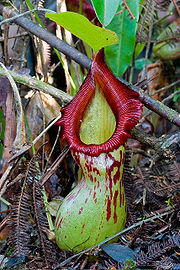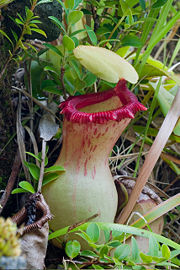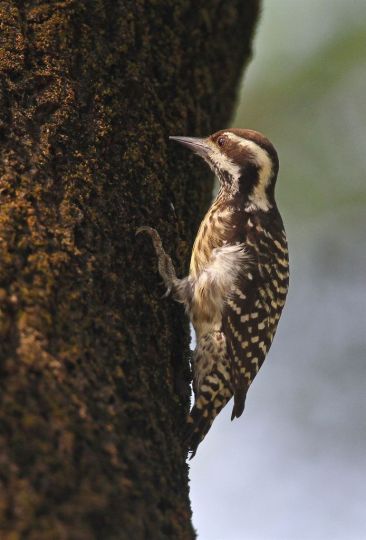Family: Pteropodidae
N. rabori is listed as Endangered because its population size is estimated to number fewer than 2,500 mature individuals, there is an observed continuing decline in the number of mature individuals, and no subpopulation contains more than 250 mature individuals.
The tube-nosed fruit bat is endemic to the Philippines, where it is restricted to the islands of Cebu (Vinciguerra and Muller 1993), Negros and Sibuyan; it might also occur in Panay, although there has been a lack of sampling there to confirm this (L. Heaney pers. comm. 2006). It has also been recorded from Karakelong in the Talaud Islands (Indonesia), and on Siao and Greater Sangihe in the Sangihe Islands (Indonesia) (K. Helgen pers. comm.), but these records represent tentative identifications. The elevational range is from sea level to 1,300 m asl. On Negros, it has been recorded from 200 to 1,300 m asl.
It is found in or adjacent to forest (sea level to 1,300 m), in both primary and secondary forest (Vinciguerra and Muller 1993). N. rabori was previously thought to be confined to high-quality forest, but it is tolerant to a wider range of habitats than previously suspected, having been recorded from degraded habitats on Negros, and persisting in very degraded habitats on Cebu. During recent collections, the species has tended to be found near bodies of water.
Deforestation is a major threat, and has been severe across much of the range of N. rabori, although the rate has slowed due to the fact that there is little remaining primary forest. Most of the lowland forest habitat, which is the most suitable for the species, has been destroyed in two out of the three islands on which the species is known to occur. Although it has recently been recorded from some areas of secondary forest, the remaining populations are under intense pressure since very little forest remains and there is a continuing decline in area and quality of this forest. Hunting is not suspected to be a threat as, according to surveys, local people are unfamiliar with this tube-nosed fruit bat.
Philippine Bats Conservation Programme
http://pbcfi.org.ph/philippine-bats
Project Dobsonia
The survival of the Philippine Bare-backed Fruit Bat (Dobsonia chapmani) is severely threatened by the destruction and degradation of forests as well as hunting on Cebu and Negros Islands, where this species is endemic. Prior to 2001, it was thought to be extinct, but its rediscovery brought to attention the urgent conservation actions that had to be taken. The project also aims to support cave and cave bat conservation initiatives in Cebu and Negros.
The rediscovery occurred in Carmen and Catmon municipalities on Cebu Island, following which PBCFI swiftly initiated the Philippine Bare-backed Fruit Bat protection project. Information campaigns and lectures were conducted to raise conservation awareness among Local Governments, and to lobby for the protection of limestone caves supporting remaining populations of this species. A government-organized group of environmental protection coordinators now conducts regular patrols to deter destructive activities, especially bat hunting. Reforestation efforts are also underway. The local government of the Carmen municipality has even adopted this bat as its flagship species, and has declared the caves where they occur as “Naked-backed Fruit Bat Sanctuaries”. Project Dobsonia now aims to conduct intensive field surveys to locate existing populations.
Mambukal Resort, known as a gateway to Mt. Kanlaon Natural Park on Negros Island, is a popular tourist destination. Its large populations of flying foxes (Golden-crowned Flying Fox Acerodon jubatus, Large Flying Fox Pteropus vampyrus and Common Island Flying Foxes Pteropus hypomelanus) are the stars of the resort. Poor ecotourism practices and management were however threatening their survival, especially for the less tolerant and critically endangered Golden-crowned Flying Fox.
PBCFI in partnership with NFEFI, conducted a seminar and provided training for Mambukal’s tour guides to educate them about the conservation status and importance of flying foxes, identification, monitoring and rescue techniques, and ecotourism best practices. This activity also fostered a long-term partnership, allowing for continued monitoring and development of ecotourism. Mambukal Resort is now a showcase site for flying fox conservation in the Philippines.
Bat Encounter
An activity jointly implemented by PBCFI and NFEFI, Bat Encounter aims to provide students and teachers with training in field research techniques. Participating institutions include University of St. La Salle-Bacolod, University of Negros Occidental-Recoletos and West Negros University. The activity provided Biology students with the capacity to conduct thesis research.
Bat Surveys
Biodiversity surveys in 2012 conducted in southwestern Negros confirmed the presence of the endangered Philippine Tube-nosed Fruit Bat (Nyctimene rabori), a species restricted to the islands of Panay and Negros. This record flags the importance of forest conservation in the area.
In Calamianes, surveys conducted in 2010 recorded the poorly known Palawan Flying Fox (Acerodon leucotis) and possible new species of insect bats. Further studies on these species remain on the agenda of the Philippine Bats Conservation Programme.
South East Asia Bat Conference Research Unit (SEABCRU)
PBCFI participated in SEABCRU 2012 held in Hat Yai, Thailand, to discuss issues on bat conservation and research.
-Ron Lauson

















